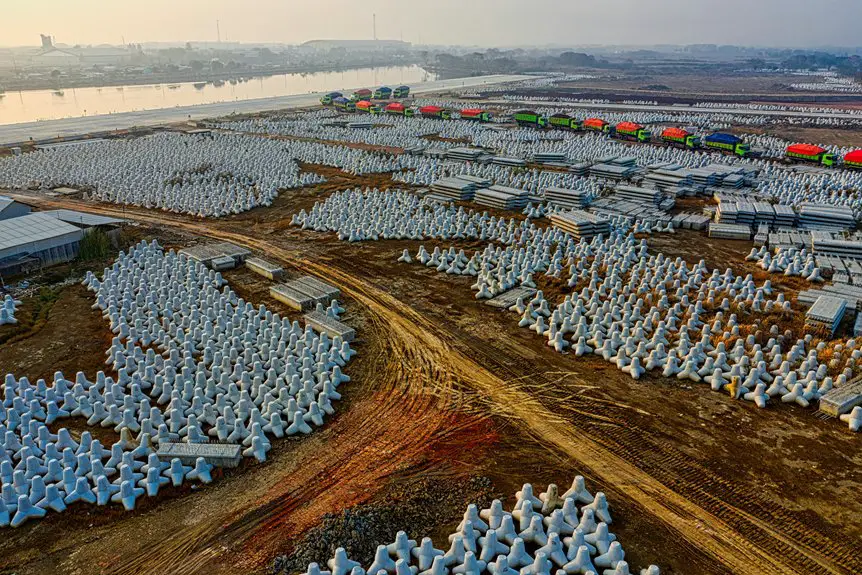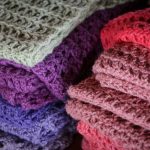If you want a soft, smooth fabric that’s highly absorbent, chamois is your go-to, ideal for cleaning or sportswear. Flannel offers a warm, fuzzy texture perfect for cozy clothing and bedding. Chamois requires gentle care, while flannel handles frequent washing better. Your choice depends on whether you need warmth or moisture-wicking. Keep exploring to understand which fabric suits your project’s needs best and how their unique qualities compare.
Table of Contents
Key Takeaways
- Chamois fabric is smooth, suede-like, highly absorbent, and often made from synthetic microfibers, while flannel is soft, fuzzy, and woven from cotton or wool for warmth.
- Flannel provides better insulation and warmth, making it ideal for clothing and bedding, whereas chamois excels in moisture-wicking and absorbency for cleaning and sportswear.
- Chamois requires gentle hand washing and air drying to maintain softness, while flannel is machine washable and more durable for frequent laundering.
- The texture preference—chamois’s sleek smoothness versus flannel’s cozy fuzziness—often guides fabric choice for different projects.
- Choose chamois for applications needing softness and absorbency, and flannel for warmth and comfort in casual or home textiles.
What Is Chamois Fabric?
Chamois fabric is a soft, pliable material originally made from the leather of the chamois goat-antelope. When you use chamois, you notice its exceptional absorbency and gentle texture, making it perfect for cleaning and polishing delicate surfaces.
Chamois fabric offers softness and superb absorbency, ideal for gently cleaning and polishing delicate surfaces.
Unlike rougher materials, chamois won’t scratch or damage what you’re working on. Today, many chamois fabrics are synthetic, designed to mimic the original’s softness while providing durability and easier care.
You’ll find chamois in products like cleaning cloths, sportswear, and gloves because it breathes well and manages moisture efficiently. If you need a fabric that’s both gentle and effective at moisture absorption, chamois is a great choice.
It combines comfort with practical performance in various everyday applications.
What Is Flannel Fabric?
Although you might associate flannel with cozy winter wear, it’s actually a soft, woven fabric made from cotton, wool, or synthetic fibers. You’ll find flannel valued for its warmth, softness, and versatility.
What makes flannel unique is its texture, created by brushing the fabric’s surface to raise fine fibers, giving it that characteristic fuzzy feel.
When you choose flannel, consider these key points:
- The weave: Flannel typically uses a plain or twill weave, which affects durability and softness.
- The finish: Brushing intensity varies, influencing how plush the fabric feels.
- The uses: You’ll see flannel in shirts, pajamas, bedding, and even casual accessories.
Understanding these aspects helps you appreciate flannel’s comfort and practical appeal.
Material Composition of Chamois and Flannel
When you compare the material composition of chamois and flannel, you’ll notice distinct differences that influence their feel and function.
Chamois is traditionally made from the leather of the chamois goat, but modern versions often use synthetic microfibers like polyester or nylon, offering softness with durability and excellent moisture-wicking properties.
Chamois combines traditional leather with modern microfibers for softness, durability, and superior moisture-wicking.
Flannel, on the other hand, is typically woven from natural fibers such as cotton, wool, or a blend, sometimes mixed with synthetic fibers for added strength. Its construction involves a plain or twill weave, providing warmth and breathability.
Understanding these compositions helps you choose between chamois’s moisture management and durability or flannel’s natural warmth and comfort, depending on your needs.
Texture and Feel Comparison
You’ll notice chamois offers a smooth, soft touch, while flannel feels cozy and warm.
Both fabrics balance breathability and durability in different ways.
Let’s explore how their textures and flexibility affect your comfort and use.
Softness and Smoothness
Because both chamois and flannel offer unique tactile experiences, understanding their softness and smoothness helps you choose the right fabric for your needs.
Chamois feels luxuriously smooth, almost suede-like, giving you a gentle, buttery touch. Flannel, by contrast, is soft but with a fuzzy, napped surface that feels cozy and inviting.
When deciding between the two, consider these points:
- Chamois delivers a sleek, polished feel that’s less textured.
- Flannel offers a plush, slightly raised nap, adding warmth and softness.
- Your preference for smoothness or a more tactile, fuzzy surface will guide your choice.
Warmth and Breathability
Choosing between chamois and flannel means weighing how each fabric balances warmth and breathability.
When you wear chamois, you’ll notice it traps heat effectively while still allowing your skin to breathe, making it ideal for cooler conditions without overheating. Its dense weave offers insulation but manages moisture well, keeping you comfortable.
Flannel, on the other hand, feels cozy and warm due to its napped surface, which creates air pockets that trap heat. However, it’s less breathable than chamois, so you might feel warmer but could also get clammy if you sweat.
If you want a fabric that warms you up while letting your skin breathe, chamois is a solid choice. For a snug, warmer feel, especially in dry conditions, flannel works well.
Durability and Flexibility
While warmth and breathability play a big role in how comfortable a fabric feels, durability and flexibility determine how it performs over time and adapts to your movements.
Chamois fabric, made from tightly woven cotton or synthetic fibers, offers remarkable durability and stretches slightly, making it ideal if you need resilience with some give.
Flannel, typically softer and looser woven, feels flexible but may wear out faster with frequent use or washing.
Consider these points:
- Chamois resists abrasion and holds shape longer.
- Flannel provides more stretch but can thin over time.
- Both fabrics soften with use, but chamois maintains strength better.
You’ll want to pick chamois for rugged wear and flannel if you prioritize gentle flexibility.
Common Uses for Chamois Fabric
Chamois fabric excels in applications where softness and absorbency matter most. You’ll often find it used in cleaning cloths because it soaks up moisture without scratching surfaces.
If you’re into cycling, chamois padding in bike shorts offers comfort by reducing friction and wicking away sweat during long rides. You might also see chamois in leather-making or as a gentle polishing cloth for delicate items like glass or cars.
When you need a fabric that’s both soft and practical for moisture control, chamois is a solid choice. Its unique texture makes it ideal for tasks requiring a gentle touch combined with strong absorbency, ensuring you get the best results without damage or irritation.
Common Uses for Flannel Fabric
You’ll often find flannel in cozy shirts, pajamas, and jackets that keep you warm.
It’s also popular for home textiles like blankets and sheets, perfect for chilly nights.
As the seasons change, flannel’s soft, insulating qualities make it a go-to choice for cooler weather.
Popular Clothing Items
Flannel fabric often finds its way into your favorite cozy shirts, pajamas, and loungewear. Its softness and warmth make it perfect for chilly days and relaxing evenings.
When you pick flannel clothing, you’re choosing comfort combined with style. Here are three popular clothing items made from flannel:
- Flannel Shirts – Classic and versatile, great for layering or wearing alone.
- Pajama Sets – Soft and breathable, ideal for a restful night’s sleep.
- Lounge Pants – Comfortable and flexible, perfect for home or casual outings.
You’ll appreciate how flannel’s natural fibers keep you warm without overheating.
Whether you’re dressing for comfort or casual style, flannel fabric clothes fit seamlessly into your wardrobe.
Home Textile Applications
Many households rely on flannel fabric for its cozy feel and durability in everyday home textiles. You’ll find flannel sheets and pillowcases offering warmth and softness, perfect for a comfortable night’s sleep.
Beyond bedding, flannel makes excellent throw blankets that add a snug touch to your living room or bedroom. It’s also popular for curtains, where its weight helps block drafts while maintaining a warm aesthetic.
If you’re into DIY, flannel is great for crafting reusable kitchen towels or soft, absorbent cloths. Its easy care and resistance to pilling mean your flannel textiles will look good and feel great after many washes.
Choosing flannel for your home textiles means you get both comfort and practicality in one fabric.
Seasonal Wear Trends
When temperatures drop, you’ll often reach for flannel clothing to stay warm and comfortable. Flannel’s soft, brushed texture makes it perfect for chilly weather, providing cozy insulation without bulk.
You’ll notice flannel is a seasonal staple, especially in:
- Casual shirts – Perfect for layering over tees or under jackets during fall and winter.
- Pajamas and loungewear – Offering warmth for relaxing evenings or cold nights.
- Accessories – Scarves and hats made from flannel keep you snug while adding style.
Because of its breathability and softness, flannel balances warmth and comfort, making it a go-to fabric for cold seasons.
You’ll find it everywhere during autumn and winter, thanks to its ability to keep you cozy without overheating.
Durability and Care Instructions
Although both chamois and flannel offer unique benefits, you’ll find their durability and care requirements differ markedly. Chamois, made from soft leather, is durable but needs gentle cleaning and conditioning to maintain suppleness. Flannel, typically cotton or wool, is easier to care for but can pill or shrink without proper washing. Understanding these differences helps you extend the life of each fabric.
| Fabric | Durability | Care Instructions |
|---|---|---|
| Chamois | High, resists wear | Hand wash, air dry, condition |
| Flannel | Moderate, may pill | Machine wash cold, tumble dry low |
| Chamois | Sensitive to heat | Avoid direct sunlight and heat |
| Flannel | Shrinks if hot | Use mild detergent |
Choosing Between Chamois and Flannel for Your Project
How do you decide whether chamois or flannel suits your project best? It depends on your intended use and desired texture.
Chamois offers a soft, suede-like finish that’s ideal if you want a smooth, absorbent fabric—perfect for cleaning cloths or upholstery. Flannel, on the other hand, provides warmth and a cozy feel, making it great for clothing or bedding.
Chamois delivers a smooth, absorbent suede-like finish, while flannel offers warmth and cozy softness.
Consider these factors to guide your choice:
- Functionality: Need absorbency or warmth? Chamois absorbs moisture well; flannel insulates.
- Texture preference: Choose chamois for softness and smoothness; pick flannel for a fuzzy, plush touch.
- Care requirements: Flannel typically withstands frequent washing better than delicate chamois.
Weigh these points to match fabric qualities with your project’s demands.
Frequently Asked Questions
Can Chamois and Flannel Fabrics Be Recycled?
You can recycle some chamois and flannel fabrics, but it depends on their material blend and local facilities. Check if your community accepts textiles, and consider donating gently used items to reduce waste and support recycling efforts.
Are Chamois and Flannel Fabrics Hypoallergenic?
You’re choosing between a gentle cloud and a warm hug. Chamois often feels hypoallergenic due to its smooth texture, while flannel, though soft, can sometimes irritate sensitive skin. So, test both before deciding.
Which Fabric Is More Environmentally Friendly?
You’ll find flannel more environmentally friendly since it’s often made from natural fibers like cotton or wool, which are biodegradable and renewable. Chamois, especially synthetic types, can have a bigger environmental footprint due to production processes.
Do Chamois and Flannel Fabrics Retain Dyes Differently?
Ever wonder why some colors fade faster on your clothes? You’ll find chamois holds dyes less intensely than flannel, which absorbs and retains dyes better, giving you richer, longer-lasting colors in your flannel garments.
Can Chamois or Flannel Fabrics Be Used for Upholstery?
You can use flannel for upholstery, but it’s less durable and may wear quickly. Chamois isn’t ideal since it’s softer and more absorbent, so it won’t hold up well under heavy use or spills.
- Schoeller Keprotec®: The Ultimate Aramid Fabric for Abrasion Resistance - June 23, 2025
- Proper Care and Recovery of Aramid Fabrics - June 23, 2025
- Plain Weave vs. Twill Weave Aramid Fiber Fabric: A Comparison - June 23, 2025







